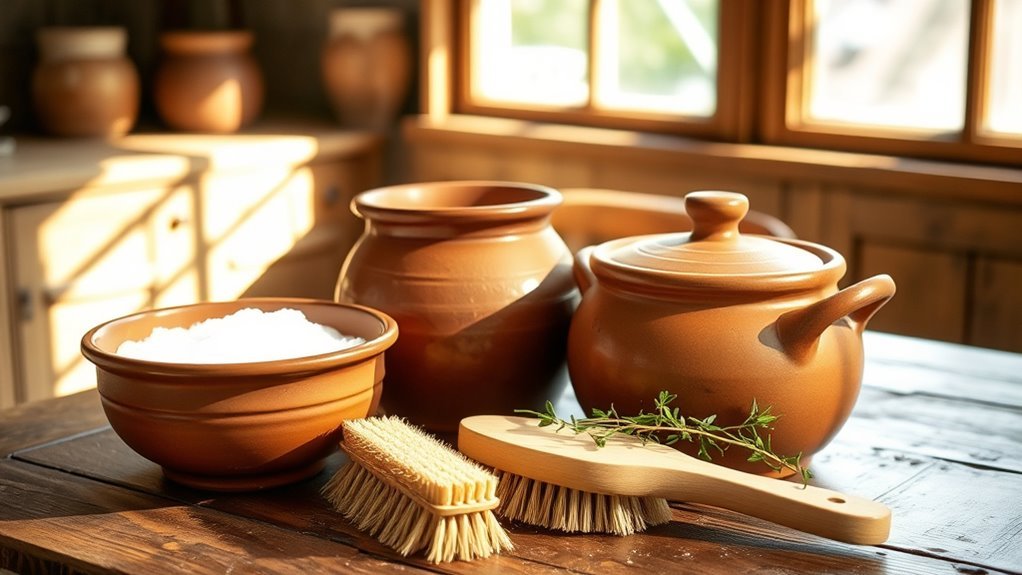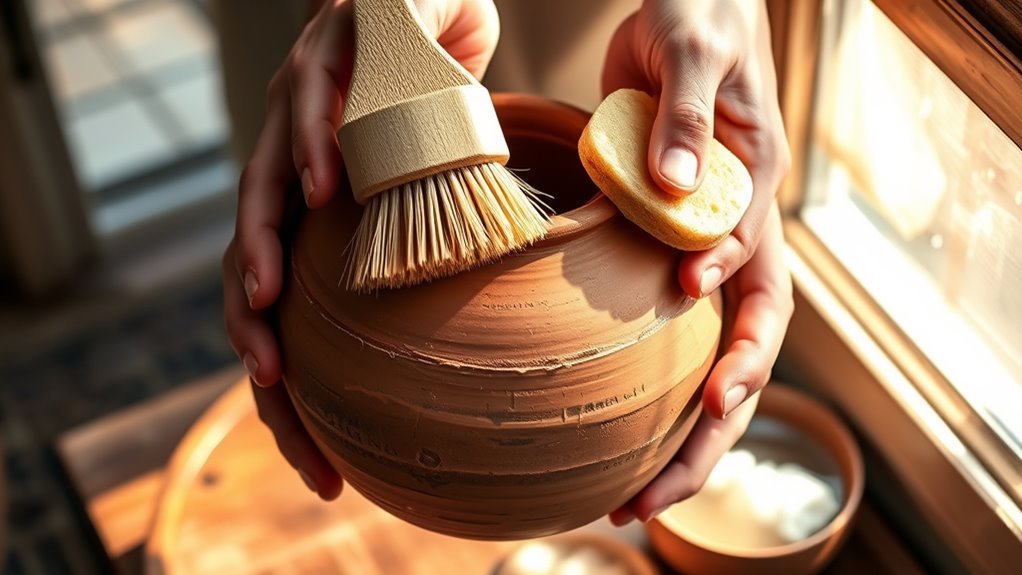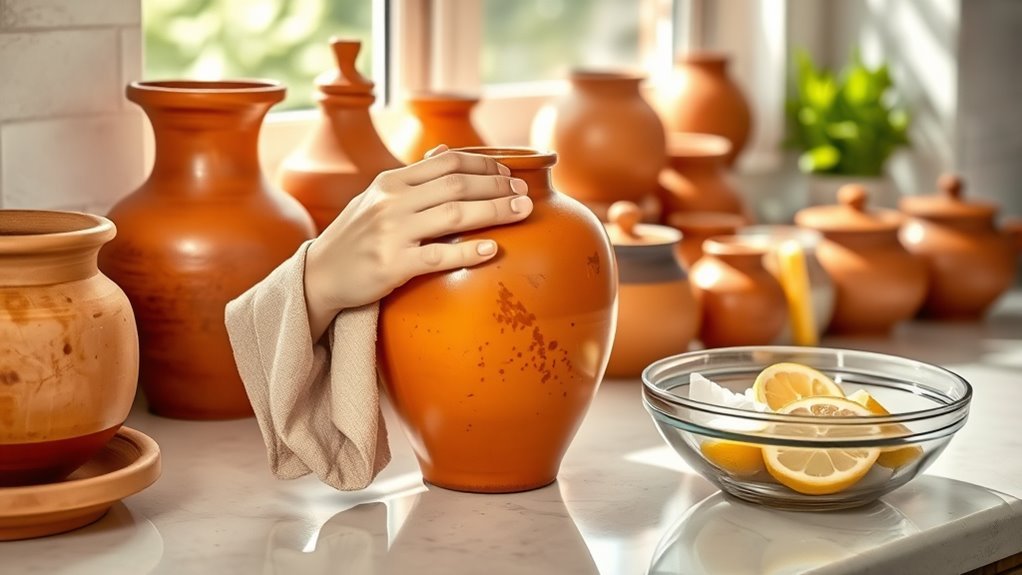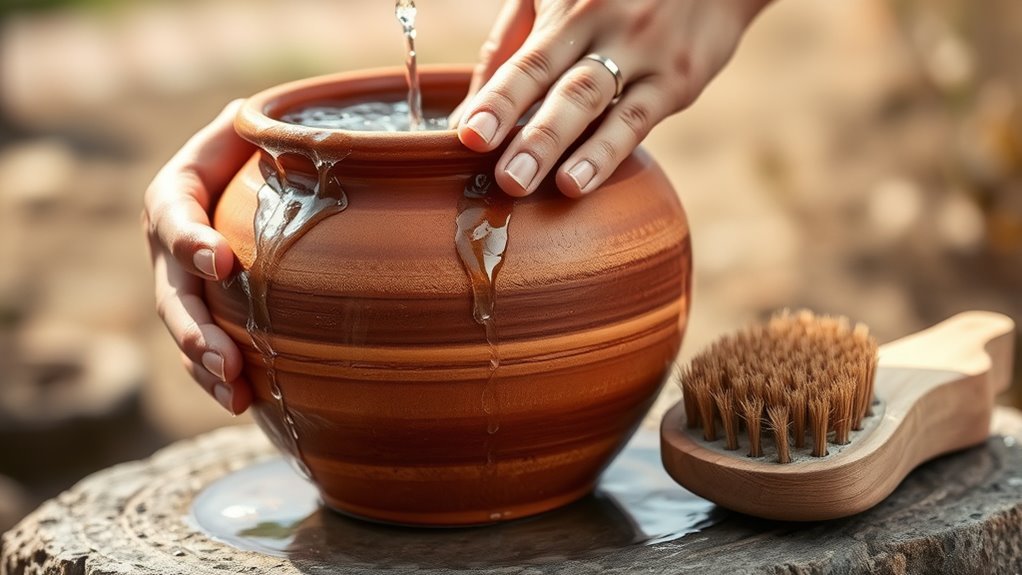How to Clean Traditional Clay or Earthenware Items
You should clean traditional clay or earthenware items gently since they’re porous and can absorb moisture or damage easily. Start by brushing off loose dirt with a soft brush. Use mild soap and warm water to wash them carefully, avoiding soaking. For stains or odors, try natural remedies like baking soda or diluted vinegar. Let them air dry completely before storing in a dry, ventilated place. Keep these simple steps in mind, and you’ll discover even more ways to protect and maintain your clay treasures.
Understanding the Nature of Clay and Earthenware

Clay and earthenware are porous materials that absorb moisture and stains easily, so you’ll need to handle them with care when cleaning. Understanding clay properties helps you appreciate why these items require gentle treatment. Clay’s natural porous structure means it soaks up liquids, making it vulnerable to damage if exposed to harsh scrubbing or chemicals. Earthenware types vary—from terracotta to red clay—each with unique textures and porosity levels. Knowing your item’s specific earthenware type guides your cleaning approach, letting you protect its surface and preserve its character. Embracing this knowledge lets you maintain your clay treasures freely, ensuring they remain beautiful and functional without feeling restricted by complicated care routines.
Preparing Your Clay Items for Cleaning
How should you get your earthenware ready before cleaning? Start with a careful pre cleaning inspection to spot cracks, chips, or stains. This helps you decide the best approach without risking damage. Every piece is unique, so keep item specific considerations in mind—porous clay may need gentler handling than glazed surfaces. Remove any loose dirt or debris by gently brushing or wiping with a dry cloth. Avoid soaking your items at this stage to prevent water absorption that could weaken the structure. By understanding the condition and characteristics of your clay, you set the stage for effective, safe cleaning. Taking these initial steps respects your earthenware’s integrity and lets you confidently move forward with care.
Gentle Cleaning Techniques for Delicate Surfaces

When cleaning delicate clay or earthenware, you’ll want to use soft bristle brushes to prevent damage. Mild soap solutions are best for removing dirt without harming the surface. Avoid abrasive scrubbing to keep your items looking their best.
Use Soft Bristle Brushes
One of the best tools you can use to gently clean delicate earthenware surfaces is a soft bristle brush. Choosing the right bristle types and mastering brush techniques helps you preserve your pieces without damage. Soft natural bristles work well on fragile surfaces, while synthetic bristles suit tougher dirt. Use gentle, circular motions or light sweeping strokes to lift debris without scraping. Here’s a quick guide to get you started:
| Bristle Type | Ideal Surface | Brush Technique |
|---|---|---|
| Natural Soft | Fragile earthenware | Circular, gentle strokes |
| Synthetic Soft | Sturdier clay | Light sweeping motions |
| Goat Hair | Porous surfaces | Soft dabbing |
| Horsehair | Textured items | Gentle flicking |
| Camel Hair | Mixed textures | Smooth, even brushing |
Respect your earthenware’s freedom to age gracefully with care.
Mild Soap Solutions
Although earthenware is delicate, you can safely clean it using mild soap solutions that won’t harm its surface. To do this, choose mild detergent options like gentle dish soaps or castile soap, which are less likely to strip the clay’s natural finish. Pay close attention to soap concentration ratios—too strong, and you risk damaging the item; too weak, and it won’t clean effectively. A good rule of thumb is mixing one teaspoon of soap with a cup of warm water. Use a soft cloth or sponge dipped in this solution to gently wipe your piece. This balanced approach lets you maintain your earthenware’s beauty without compromising its integrity, giving you the freedom to keep your cherished items clean and vibrant.
Avoid Abrasive Scrubbing
Since clay and earthenware surfaces are fragile, you’ll want to steer clear of abrasive scrubbing that can cause scratches or wear. Using abrasive materials like steel wool or rough sponges will damage the delicate finish and reduce the lifespan of your item. Instead, opt for gentle scrub techniques—soft cloths or non-abrasive brushes are perfect for loosening dirt without harm. When cleaning, avoid excessive force; let mild soap solutions and warm water do the heavy lifting. Taking it easy lets you maintain the natural beauty and freedom these pieces represent. Remember, the goal is to preserve, not polish aggressively. By avoiding abrasive materials and harsh scrub techniques, you’ll protect your clay or earthenware’s unique character for years to come.
Removing Stubborn Stains and Odors

When stains and odors cling to your clay or earthenware, natural solutions can be surprisingly effective. You’ll want to use gentle methods like baking soda or vinegar to lift stains and neutralize smells without damaging the surface. Let’s explore how these simple ingredients can refresh your pieces safely.
Natural Stain Removal
If you’ve noticed stubborn stains or lingering odors on your clay or earthenware items, natural remedies can be surprisingly effective. You don’t have to rely on harsh chemicals—instead, try natural stain removal techniques that respect your freedom to use safe, eco-friendly methods. A simple paste made from baking soda and water works wonders; apply it gently to the stain, let it sit for 15-20 minutes, then rinse thoroughly. Another technique is using white vinegar diluted with water—dab it onto the stain, allowing natural acids to break down residue without damaging your item. These approaches give you control, letting you clean effectively while preserving the integrity of your cherished pieces. Embracing natural stain removal techniques means you’re free to maintain your clayware safely and sustainably.
Odor Elimination Techniques
Natural methods can tackle more than just stains; they’re also great for eliminating stubborn odors from your clay or earthenware items. You want your pieces to feel fresh without harsh chemicals, so try these odor absorption and scent neutralization techniques:
- Baking Soda Soak: Fill your item with warm water and add a couple of tablespoons of baking soda. Let it soak overnight to absorb lingering smells.
- White Vinegar Rinse: Mix equal parts water and white vinegar, then rinse your item thoroughly. Vinegar naturally neutralizes odors without leaving a scent.
- Coffee Grounds Treatment: Place dry coffee grounds inside the item and seal it for 24 hours. Coffee is a powerful natural deodorizer that traps unwanted odors.
These methods free your clay or earthenware from stubborn smells, keeping them fresh and ready to use.
Drying and Storing Clay and Earthenware Properly
Although clay and earthenware items are durable, you’ll want to dry them thoroughly before storing to prevent moisture buildup that can lead to mold or cracking. Use effective drying techniques like air drying in a well-ventilated area or gently patting with a soft cloth to absorb excess water. Avoid direct sunlight, which can cause uneven drying and damage. When it comes to storage solutions, choose a cool, dry place with good airflow. Stack items carefully, using soft padding between pieces to avoid chipping. Open shelves or cabinets with ventilation work best, letting your items breathe freely. By mastering these drying and storage habits, you keep your clay and earthenware in great shape, ready for your next adventure with them.
Tips for Maintaining the Longevity of Your Clay Items
Proper drying and storage lay the groundwork for keeping your clay items in good shape, but maintaining their longevity involves a few more careful habits. To truly free your earthenware from damage and wear, follow these clay maintenance tips:
- Handle with care – Avoid sudden temperature changes and rough handling to prevent cracks.
- Regular cleaning – Use gentle, non-abrasive methods and avoid harsh chemicals that can degrade the clay’s surface.
- Seal when needed – Apply natural sealants or food-safe oils to help protect porous surfaces and enhance earthenware preservation techniques.
Frequently Asked Questions
Can Clay Cookware Be Used in a Dishwasher Safely?
You might want to rethink putting clay cookware in the dishwasher. While it’s tempting for convenience, dishwasher safety isn’t guaranteed for these items. The high heat and harsh detergents can cause cracking or fading, limiting your freedom to enjoy your cookware longer. Instead, hand washing is safer and helps preserve your clay cookware’s natural qualities. So, if you want your pieces to last, skip the dishwasher and clean them gently by hand.
Is It Safe to Use Soap on Unglazed Clay Pots?
Did you know that unglazed clay pots can absorb up to 30% of their weight in water? Because of this, using soap on them isn’t the safest choice—it can seep in and affect flavor. Instead, you’ll want to explore soap alternatives like baking soda or just hot water for cleaning. These gentle cleaning techniques preserve the pot’s natural qualities, giving you the freedom to enjoy authentic cooking without risking damage.
How to Fix Cracks in Traditional Clay Pots?
If you want to fix cracks in your traditional clay pots, start with crack repair using a mix of powdered clay and water to create a paste. Apply it gently to the crack, then let it dry completely. For pot restoration, sanding the area smooth afterward helps. This way, you maintain the pot’s natural charm while giving it new life, so you’re free to enjoy your piece without worry.
Can Traditional Clay Items Be Used in a Microwave?
When it comes to microwave safety, don’t put all your eggs in one basket with traditional clay items. Clay materials often have tiny pores that can trap moisture, causing them to crack or even explode in the microwave. Unless your clay piece is specifically labeled microwave-safe, it’s best to avoid using it there. You want freedom in your kitchen, but not at the cost of broken pottery or a messy microwave!
Are There Any Natural Sealants for Earthenware Surfaces?
If you’re looking for natural alternatives to seal earthenware surfaces, you’ve got some great options that keep things simple and eco-friendly. Beeswax is a popular choice—it soaks in nicely and adds a subtle shine. You can also try natural oils like linseed or tung oil for effective sealing techniques that protect while preserving the clay’s breathability. These methods let you enjoy your pieces without relying on synthetic coatings, keeping your freedom to use and care for them naturally.






